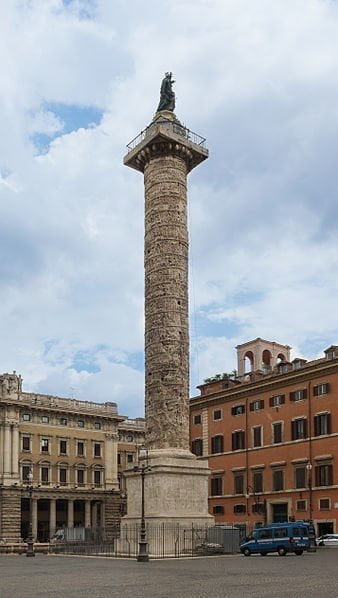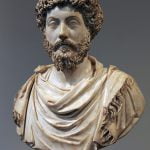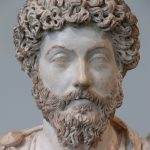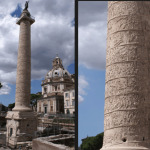Chapters
Marcus Aurelius Column is a monument commemorating the victory of Roman troops, under the command of Emperor Marcus Aurelius, during the Marcomannic Wars (167-180 CE). Construction began in 180 CE and completed until 193 CE (after his death), as evidenced by the preserved inscription found near the column. Currently, the monument is located in Piazza Colonna in Rome.
The column was originally placed on the northern edge of the Martian Field, next to the Temple of Neptune. The model for the structure was the existing Trajan’s column, which commemorated the victory of the ruler over Dacians. Here, too, the shaft of the column is decorated with beautiful and detailed reliefs depicting scenes of the Markoman Wars.
The column was made of white Carrara marble, exactly from 27-28 blocks (each is 3.7 meters in diameter). Its height is almost 30 meters. At the top of the column was a monument to Marcus Aurelius, which in 1589 was replaced with the visible to this day figure of St. Paul the Apostle.
The platform at the top can be accessed by stairs in the column (there are about 200 of them in total). In the Middle Ages, the use of stairs was only possible for a fee. Currently, you cannot use the stairs because of the protection of the monument.
Scenes from the Marcomannic Wars
Reliefs were made on a ribbon that wraps Doric column in turns. The carvings tell events in a chronological manner during the fights of Marcus Aurelius with barbarian tribes in Central Europe.
We see, among others soldiers crossing the Danube (probably in Carnuntum) or the famous “miracle” when the thirsty Romans were besieged by the army of Quadi. The pleading pleas of the soldiers were to bring downpour, which Christians later attributed to the intercession of Christ.
Attention should be paid to the extraordinary detail in the details of the reliefs. We see suffering barbarians and captured women and children. Scientists also pay attention to the unnaturally large heads of the characters, so that the viewer can better read emotions from the face. The scenes are more visible thanks to the deeper grooves in the stone.








